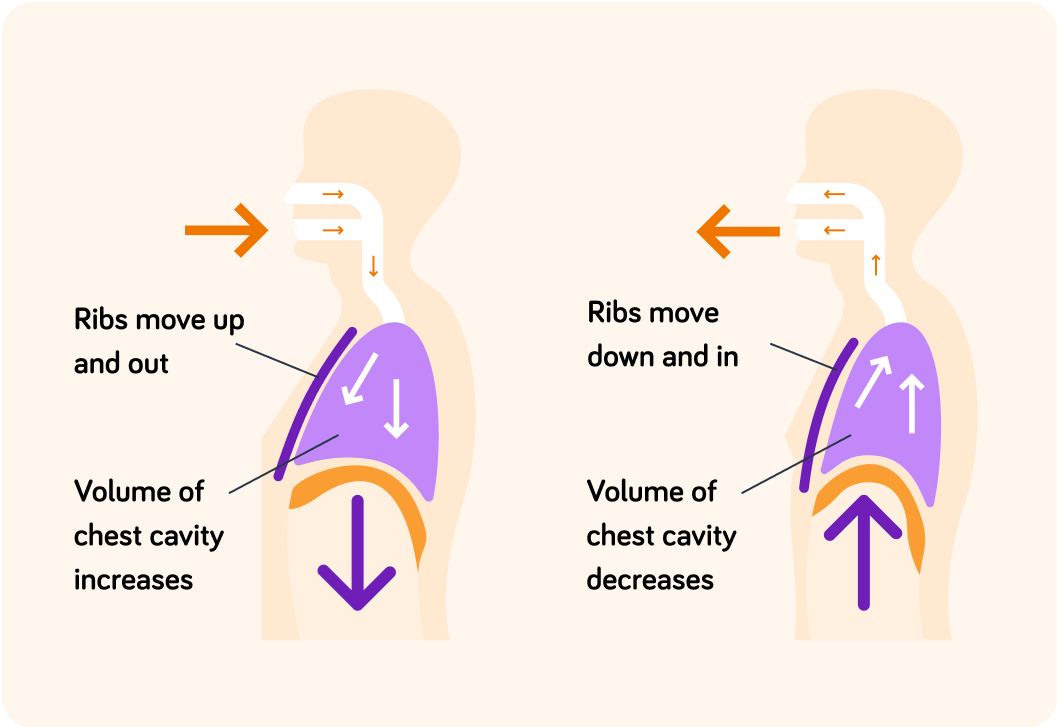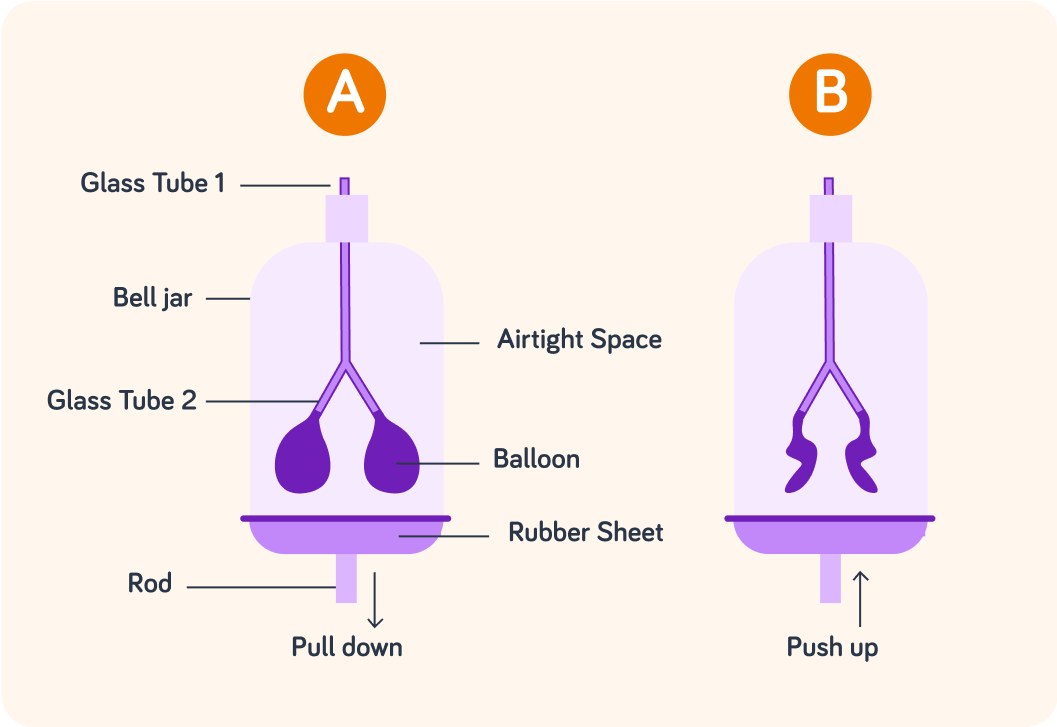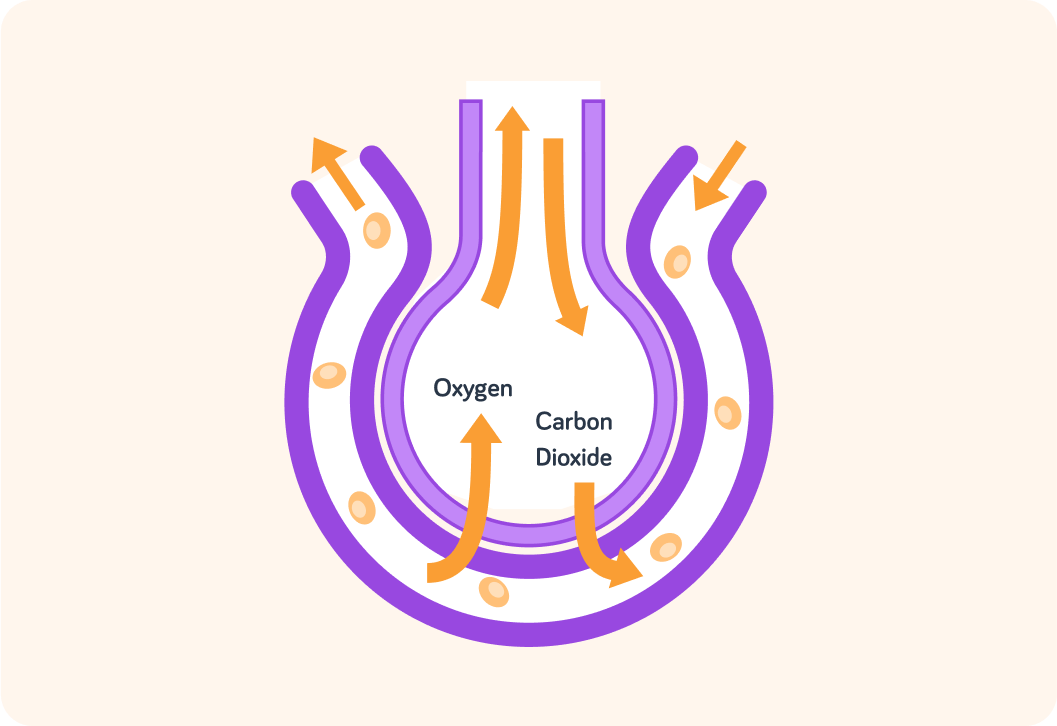YOU ARE LEARNING:
Inhaling and Exhaling

Inhaling and Exhaling
Inhaling and exhaling allows for gas exchange to swap carbon dioxide for oxygen, which are products of respiration.
Your thorax expands when you breathe in and gets smaller when you breathe out. Why do you think your thorax needs to expand when you breathe in?

Breathing is the physical process of moving air in and out of the body. Breathing in is called inhalation, breathing out is called exhalation. The diaphragm and intercostal muscles between the ribs help you to breathe. They expand the thorax which "pulls" air particles into the body.
Inhalation (sometimes also called "inspiration")
The intercostal muscles between the ribs contract, moving the ribs upwards and outwards. The diaphragm contracts and flattens. The space (volume) inside the chest cavity increases, expanding the lungs. This decreases the pressure in the chest cavity and air moves into the lungs.

Exhalation (sometimes also called "expiration")
The intercostal muscles between the ribs relax, moving the ribs downwards and inwards. The diaphragm relaxes into its dome shape. The space inside the chest cavity decreases, shrinking the lungs. This increases the pressure in the chest cavity and air moves out of the lungs.

The process of ________ draws air into the body.

During inhalation, the diaphragm...

Why do you think air moves into the chest cavity when the volume inside the cavity increases? Pick the option that describes best what happens.

Volume increases during inhalation
The same amount of gas is in a much bigger space, so the pressure in the chest is lower than the pressure of the air outside the body. Atmospheric pressure forces air into the lungs.

Volume decreases during expiration
The same amount of gas is trying to fit in a smaller space, so the pressure in the chest is higher than the pressure outside the body. As a result, air is forced out of the lungs.

Which set-up, A or B, do you is a model of inhalation?


What do you think is represented by 'glass tube 2'?
A) Trachea B) Bronchus C) Bronchiole


As well as of the breathing system of humans...
this set-up also displays the underlying principle of muscle action and difference in air pressure.

If you use a straw to blow into lime water, the water turns milky. What do you think this means?

So the air we breathe out is different to the air we breathe in. What is it our bodies take from the air?

So we breathe in to obtain oxygen from the air around us. When we breathe out, there is more of a different kind of gas. Which one?

So there is more oxygen in the air we breathe in and less in the air we breathe out. Vice versa, there is less carbon dioxide in the air we breathe in and a lot more in the air we breathe out.
Inhaled air Oxygen: 20.95% Carbon dioxide: 0.04%
Exhaled air Oxygen: 16.2% Carbon dioxide: 4%
So when you blow through a straw into a glass of lime water, the lime water turns milky because of the extra carbon dioxide in the air you breathe out.
What does the body need oxygen for?

Where does the extra carbon dioxide in the air we breathe out come from?

The difference in composition between inhaled and exhaled air can be explained by what happens during gaseous exchange at the alveoli.
The alveoli are the best sites for gaseous exchange. They have a large surface area that is kept moist and in close contact with blood pumped from the heart to the lungs. Remember that gases need to be in solution to diffuse into and out of the blood.

Carbon dioxide's movement
Blood from the heart is rich in carbon dioxide, which is a waste product of cellular respiration. The air we breathe in contains only very little carbon dioxide. So at the alveoli, carbon dioxide diffuses down the concentration gradient, from the blood into the alveoli for removal by exhalation.

Oxygen's movement
Blood from the heart contains less oxygen because the cells have used it for cellular respiration. The air we breathe in has more oxygen than the blood coming to the alveoli. So oxygen diffuses from the alveoli into the blood.

The movement of oxygen from the alveoli into the blood is prompted by a...

